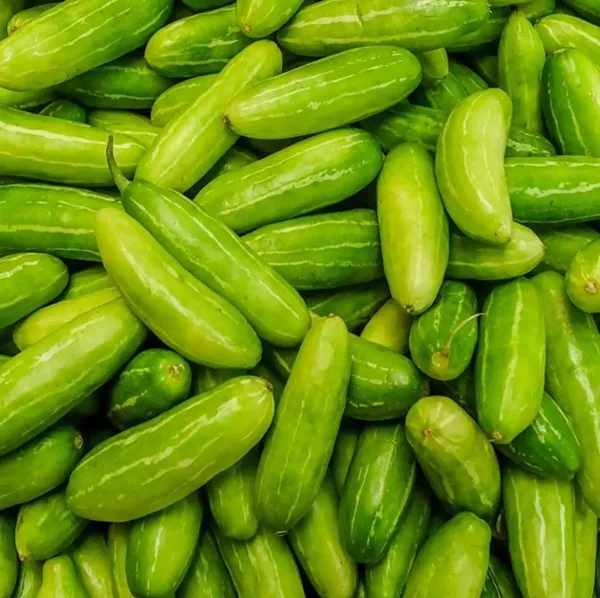Table of Contents
Ridge Gourd (Chinese Okra): The Versatile Vine of the Tropics
From Garden to Table – A Staple of Asian Cuisine
Overview
Ridge gourd (Luffa acutangula), also known as Chinese okra, angled luffa, or turai (India), is a tropical vine prized for its tender, ribbed fruits and spongy mature fibers. Native to South Asia, it thrives in warm climates and is a culinary cornerstone in Indian, Chinese, and Southeast Asian dishes. Beyond the kitchen, its fibrous skeleton is harvested as eco-friendly loofah sponges, blending utility with sustainability.
Global Varieties, Colors, and Taste
- Indian Turai:
- Color: Dark green with prominent ridges.
- Taste: Mild, slightly sweet; tender when young.
- Chinese Okra:
- Color: Pale green, longer (up to 12 inches).
- Taste: Subtle bitterness, akin to zucchini.
- Smooth Luffa (Luffa cylindrica):
- Color: Light green; fewer ridges.
- Taste: Similar but often grown for sponges.
Nutrition & Glycemic Index (GI)
- Calories: 20 per 100g.
- Key Nutrients:
- Vitamin C (12% DV), Vitamin B5, magnesium, dietary fiber.
- Antioxidants: Flavonoids, saponins.
- Glycemic Index: 15 (very low), ideal for diabetics and weight management.
Health Benefits & Risks
- Benefits:
- Detoxification: High water content (95%) supports kidney health.
- Digestive Aid: Fiber promotes gut regularity.
- Anti-Inflammatory: Reduces joint pain in traditional medicine.
- Allergies: Rare but possible cross-reactivity with melons or cucumbers.
Cultivation & Plant Structure
- Plant Structure:
- Vine: Fast-growing climber (up to 30 feet) with tendrils and lobed leaves.
- Flowers: Bright yellow, monoecious (male and female flowers).
- Fruit: Cylindrical, 6–12 inches long, with 10 distinct ridges.
- Growth & Yield:
- Time to Harvest: 60–90 days from planting.
- Yield: 8–12 tons/acre under optimal conditions.
Global Production & Trade
- Top Producers:
- India: Largest producer (Maharashtra, Karnataka); called turai or beerakaya.
- China: Grown in Guangdong and Fujian provinces.
- Thailand: Used in soups like kaeng liang.
- Exporters: India, Vietnam, Thailand.
- Importers: USA, UAE, UK (Asian diaspora demand).
- ROI:
- Initial Cost: $1,500–$2,500/acre (seeds, trellises).
- Profit: $4,000–$6,000/acre (higher for organic or sponge production).
Byproducts & Storage
- Byproducts:
- Loofah Sponges: Mature fruits dried and peeled for bath or dish scrubs.
- Seed Oil: Cold-pressed for cosmetics (moisturizing properties).
- Storage:
- Fresh: 5–7 days refrigerated in plastic wrap.
- Freezing: Blanch sliced pieces for 2 minutes; store up to 10 months.
- Canning: Preserve in brine or pickle with spices (6–12 months).
Culinary Uses & Quick Recipes
- Indian Classics:
- Stir-Fry (Turai Sabzi): Sauté with cumin, turmeric, and grated coconut.
- Curry (Beerakaya Pappu): Cook with lentils, tamarind, and chili.
- Chinese Style:
- Ridge Gourd Soup: Simmer with ginger, mushrooms, and tofu.
- Quick Recipes:
- Stuffed Ridge Gourd: Hollow and fill with spiced chickpea flour; steam or fry.
- Chutney: Blend cooked ridge gourd with mint, garlic, and lemon.
Climate & Home Growing
- Climate Needs:
- Temperature: 25–35°C; frost-sensitive.
- Rainfall: 600–1200 mm annually; drought-tolerant once established.
- Home Gardening:
- Soil: Well-drained loam (pH 6.0–6.8).
- Trellising: Essential for vertical growth; use bamboo poles or nets.
- Pollination: Hand-pollinate female flowers (identified by tiny fruit base) if bees are scarce.
Pests & Management
- Fruit Flies: Lay eggs under skin; use neem oil or pheromone traps.
- Aphids: Spray with soapy water or introduce ladybugs.
- Powdery Mildew: Treat with sulfur-based fungicides.
Popularity in Asia
- India: A monsoon staple; featured in Ayurveda for cooling properties.
- China: Symbolizes longevity; used in stir-fries and medicinal teas.
- Philippines: Called patola; key ingredient in sinigang (sour soup).
Sustainability & Market Trends
- Eco-Friendly: Loofah sponges replace synthetic scrubbers.
- Vegan Demand: Rising in Europe and North America for plant-based diets.
- Climate Resilience: Thrives in marginal soils with minimal inputs.
Conclusion
Ridge gourd’s dual role as a nourishing vegetable and sustainable resource underscores its agricultural and cultural value. From Indian curries to Chinese soups, it bridges tradition and modernity, while its sponges offer a green alternative to plastic. As global markets embrace eco-conscious living, this humble vine is poised to cultivate both health and sustainability worldwide.
Sources: FAO, Indian Institute of Horticultural Research, Journal of Ethnopharmacology.









